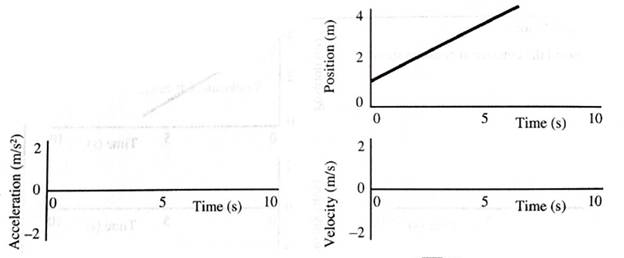
Tutorials in Introductory Physics
1st Edition
ISBN: 9780130970695
Author: Peter S. Shaffer, Lillian C. McDermott
Publisher: Addison Wesley
expand_more
expand_more
format_list_bulleted
Concept explainers
Textbook Question
Chapter 1.2, Problem 1dT
Description of Motion:

Expert Solution & Answer
Want to see the full answer?
Check out a sample textbook solution
Students have asked these similar questions
Give 3 examples where you can use the projectile
motion concept on your daily living.
what is the model of projectile motion as the combination of independent horizontal and vertical motion?
how is the concept of projectile motion used in real life?
Chapter 1 Solutions
Tutorials in Introductory Physics
Ch. 1.1 - Each person in your group should obtain a ruler...Ch. 1.1 - Each person in your group should obtain a ruler...Ch. 1.1 - Each person in your group should obtain a ruler...Ch. 1.1 - Each person in your group should obtain a ruler...Ch. 1.1 - Each person in your group should obtain a ruler...Ch. 1.1 - Each person in your group should obtain a ruler...Ch. 1.1 - Each person in your group should obtain a ruler...Ch. 1.1 - A. In the space below, sketch a possible ticker...Ch. 1.1 - B. Together with your classmates, take your ticker...Ch. 1.1 - C. Based on your observations of your tape segment...
Ch. 1.1 - D. Review your earlier interpretation of the speed...Ch. 1.1 - E. Suppose you selected two widely separated dots...Ch. 1.2 - The computer program assumes a particular...Ch. 1.2 - Description of Motion:Ch. 1.2 - Description of Motion:Ch. 1.2 - Description of Motion:Ch. 1.2 - How are the motions in parts C and D similar? How...Ch. 1.2 - Description of Motion:Ch. 1.2 - Description of Motion:Ch. 1.2 - Description of Motion: Move toward the detector...Ch. 1.2 - How do the acceleration graphs for F, G, and H...Ch. 1.2 - Description of Motion: Initially move away from...Ch. 1.2 - Description of Motion:Ch. 1.2 - Description of Motion:Ch. 1.2 - The term decelerate is often used to indicate that...Ch. 1.3 - Draw vectors on your diagram that represent the...Ch. 1.3 - B. In the space at right, compare the velocities...Ch. 1.3 - Consider the change in velocity vector between two...Ch. 1.3 - Use the definition of acceleration to draw a...Ch. 1.3 - Does the acceleration change as the ball rolls up...Ch. 1.3 - Generalize your results thus far to answer the...Ch. 1.3 - Choose two successive points. In the space at...Ch. 1.3 - In the space at right, draw a vector to represent...Ch. 1.3 - Choose a point before the turnaround and another...Ch. 1.3 - Suppose that you had chosen the turnaround as one...Ch. 1.3 - In the space at right, draw a vector that...Ch. 1.4 - Prob. 1aTCh. 1.4 - If you were to choose a different origin for the...Ch. 1.4 - On a separate part of your paper, copy the...Ch. 1.4 - Suppose you were to choose a new point on the...Ch. 1.4 - On a separate part of your paper, copy the...Ch. 1.4 - Suppose the object started from rest at point E...Ch. 1.4 - At several points on each of the diagrams below,...Ch. 1.5 - The second diagram at right shows the positions of...Ch. 1.5 - The picture of the spaceships and shuttle from the...Ch. 1.5 - Prob. 1cTCh. 1.5 - Spaceship C moves so as to remain a fixed distance...Ch. 1.5 - Consider the following statement: "The...Ch. 1.5 - Prob. 1fTCh. 1.5 - Describe the motion of the car and the truck...Ch. 1.5 - Complete the diagram at right by drawing the car...Ch. 1.5 - Use your completed diagram to sketch average...Ch. 1.5 - During a small time interval t from just before to...
Additional Science Textbook Solutions
Find more solutions based on key concepts
14. A rifle is aimed horizontally at a target 50 m away. The bullet hits the target 2.0 cm below the aim point....
Physics for Scientists and Engineers: A Strategic Approach with Modern Physics (4th Edition)
If acceleration is proportional to the net force or is equal to net force.
Conceptual Physics (12th Edition)
Suppose we found an organism on Earth with the characteristics described. In light of our current understanding...
Life in the Universe (4th Edition)
2. Frame ‘S’ moves relative to frame S as shown in FigureQ27.2
Figure Q27.2
a. A ball is at rest in frame S?. ...
College Physics: A Strategic Approach (3rd Edition)
65. || A pickup truck is carrying a toolbox, but the rear gate of the truck is missing, so the box will slide o...
College Physics (10th Edition)
3. What is free-fall, and why does it make you weightless? Briefly describe why astronauts are weightless in th...
The Cosmic Perspective (8th Edition)
Knowledge Booster
Learn more about
Need a deep-dive on the concept behind this application? Look no further. Learn more about this topic, physics and related others by exploring similar questions and additional content below.Similar questions
arrow_back_ios
SEE MORE QUESTIONS
arrow_forward_ios
Recommended textbooks for you
 An Introduction to Physical SciencePhysicsISBN:9781305079137Author:James Shipman, Jerry D. Wilson, Charles A. Higgins, Omar TorresPublisher:Cengage Learning
An Introduction to Physical SciencePhysicsISBN:9781305079137Author:James Shipman, Jerry D. Wilson, Charles A. Higgins, Omar TorresPublisher:Cengage Learning College PhysicsPhysicsISBN:9781938168000Author:Paul Peter Urone, Roger HinrichsPublisher:OpenStax College
College PhysicsPhysicsISBN:9781938168000Author:Paul Peter Urone, Roger HinrichsPublisher:OpenStax College

An Introduction to Physical Science
Physics
ISBN:9781305079137
Author:James Shipman, Jerry D. Wilson, Charles A. Higgins, Omar Torres
Publisher:Cengage Learning

College Physics
Physics
ISBN:9781938168000
Author:Paul Peter Urone, Roger Hinrichs
Publisher:OpenStax College
Position/Velocity/Acceleration Part 1: Definitions; Author: Professor Dave explains;https://www.youtube.com/watch?v=4dCrkp8qgLU;License: Standard YouTube License, CC-BY